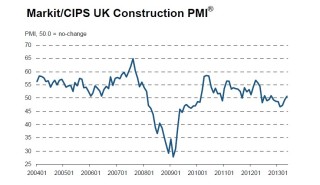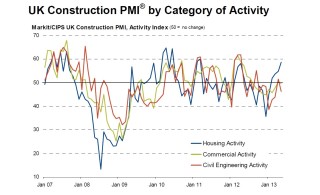May data indicated a moderate rebound in both output levels and intakes of new work across the UK construction sector, largely driven by improvements in the residential building sector, which increased at its fastest pace for more than two years.
The seasonally adjusted Markit/CIPS UK construction purchasing managers’ index (PMI) scored 50.8. Anything above 50 represents growth. It was up from 49.4 in April.
The index, which measures overall output in the construction sector, had registered below the 50 no-change value in each of the six months leading up to May. Nonetheless, the latest reading still indicated only a marginal pace of expansion and the index remained below its long-run series average (53.9).
Higher levels of construction output were driven by a robust and accelerated expansion of residential activity in May. The latest increase in house building work was the fastest for 26 months. Meanwhile, the latest survey pointed to further reductions in commercial construction and civil engineering activity, although in both cases the pace of decline eased since April.
The rise in overall construction output during May was supported by the first improvement in new business volumes for 12 months. However, the rate of new order growth was only marginal and weaker than the long-run series average. Companies that reported an increase in new work generally cited stronger demand within the residential building sector.
There is also growing optimism across construction purchasing managers, with 40% expecting a rise in output over the next 12 months, compared to 13% expecting a reduction. This shows an improvement in business confidence since April.
Input buying decreased in May for the 12th consecutive month, although the latest reduction was the joint-slowest seen over this period. Survey respondents indicated another substantial lengthening of lead-times from vendors in May. The latest deterioration in vendor performance was the most marked since September 2007, largely reflecting low stocks and capacity shortages at suppliers.
Average input costs increased for the 40th successive month in May. The latest survey indicated a robust pace of inflation that was the fastest in 2013 to date. Anecdotal evidence generally linked higher cost burdens to rising energy prices.

Tim Moore, senior economist at Markit and author of the Markit/CIPS Construction PMI, said: “UK construction output appears to have finally pulled out of a tailspin in May, but the latest figures suggest that the sector is worryingly reliant on residential building work for thrust. Construction firms cited improving house building activity as the key factor behind a rise in new orders for the first time since May 2012. Meanwhile, shrinking spending on both commercial and civil engineering projects acted as a drag on overall new business growth.
“While the latest survey provides some hope that rising construction output will support UK GDP in the second quarter, the sector remains unlikely to contribute positively to labour market conditions. May data indicated stagnant employment levels at construction firms, with survey respondents noting that cautious job hiring polices persisted across the sector in spite of a slight improvement in output volumes.”
David Noble, chief executive officer of the Chartered Institute of Purchasing & Supply, said: “The construction sector seems to have turned a corner after six dismal months. The improvement has been fuelled by a boon in house building, but the sector remains bogged down by contractions in commercial construction and civil engineering. Whilst confidence for the year ahead remains high, the poor performance of suppliers and flat levels of employment will serve as a reality check to construction and the wider UK economy.
“The government’s attempts to boost house-building have given months of lacklustre growth a shot in the arm, but the continued decline in civil engineering can be largely attributed to the lack of public sector projects, which show no sign of increasing. This, coupled with poor performance in the commercial sector, means house building alone is driving industry growth.
“Supplier performance in May was the weakest since 2007, reflecting the slow pace of growth filtering through the supply chain, which continues to recover from the recession. This is typified by shortages of capacity, low stocks and worsening lead times which have reduced suppliers’ capacity to meet demand as the sector tries to gear up for recovery. This will need to improve, before the sector sees a return to previous levels of output.”
Got a story? Email news@theconstructionindex.co.uk





